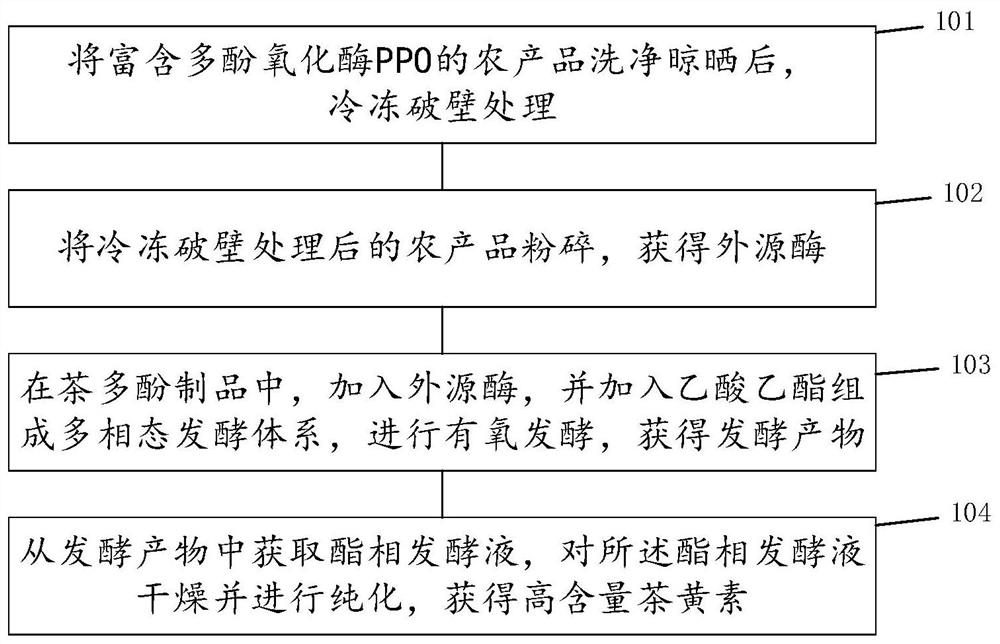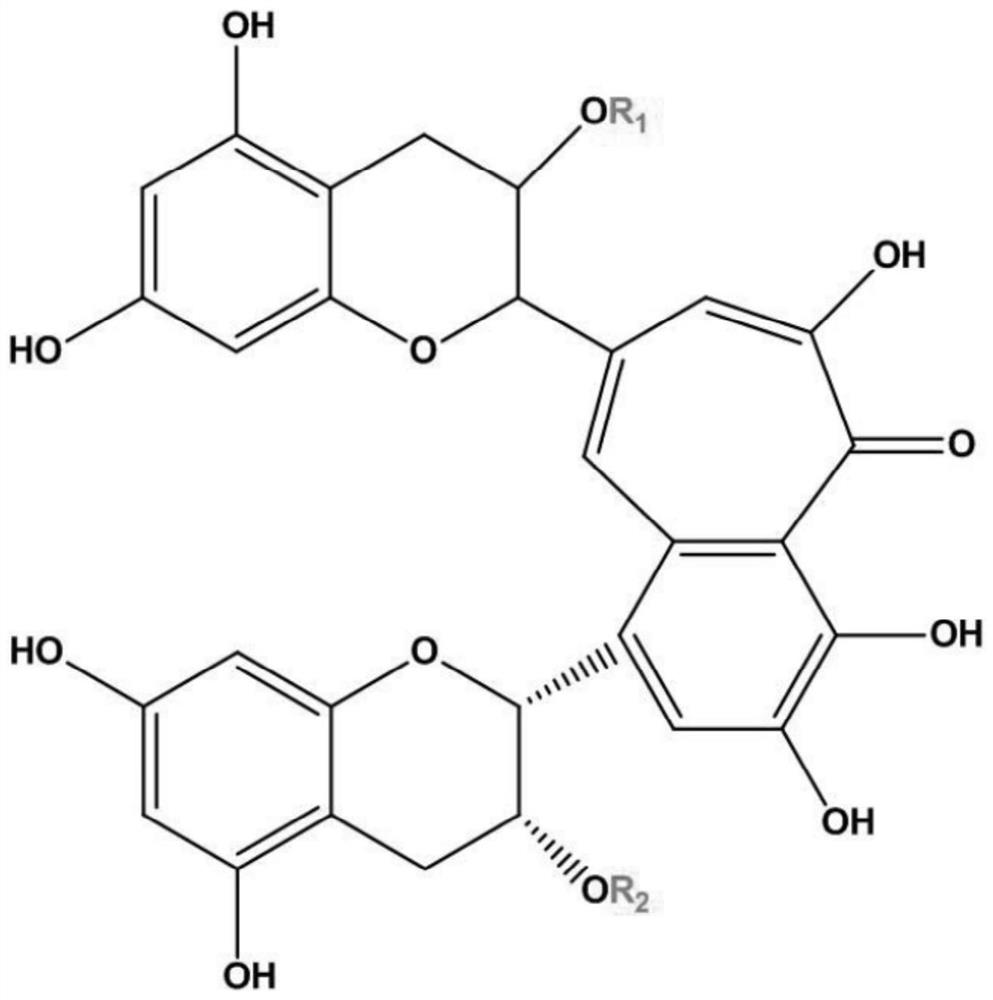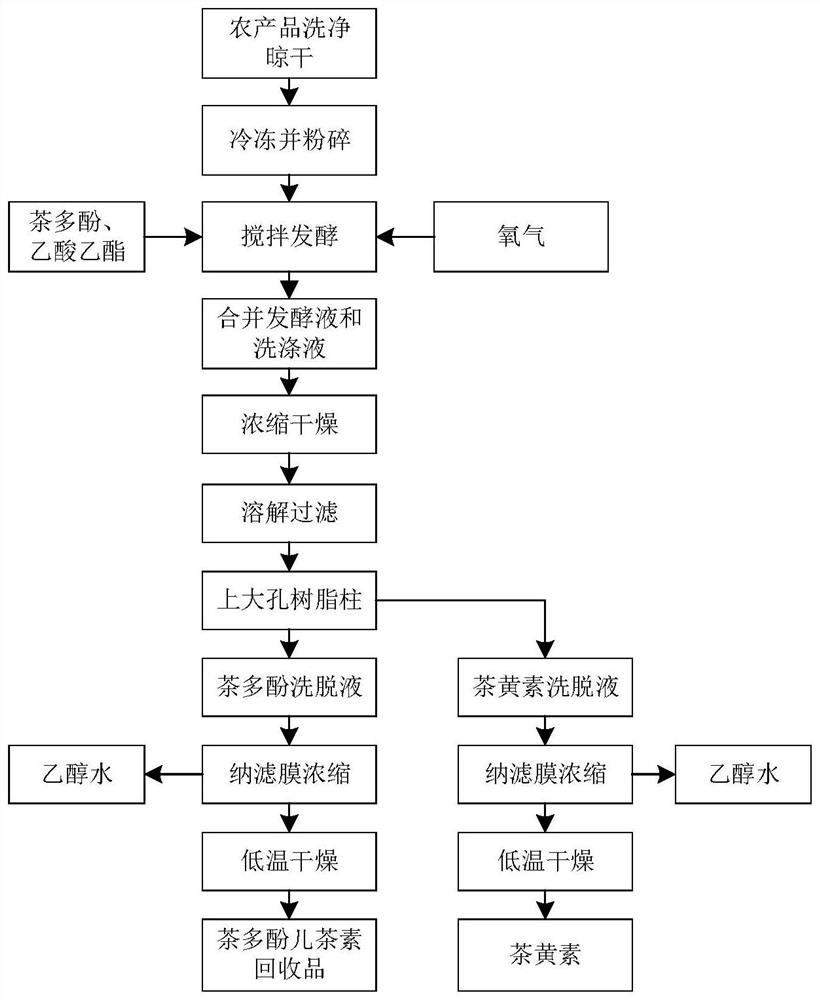Method for preparing theaflavin from exogenous enzyme and product prepared by method
A technology of theaflavin and exogenous enzyme, applied in the field of tea processing, can solve the problems of high cost of immobilized enzyme, changes in the expression of steric phase activity, etc., and achieve the effects of stable enzyme activity, great economic advantages and wide sources.
- Summary
- Abstract
- Description
- Claims
- Application Information
AI Technical Summary
Problems solved by technology
Method used
Image
Examples
Embodiment 1
[0098] Aerobic fermentation: Wash and dry the commercial Fengshui pears, take them out after freezing for 12 hours, pulverize them in a 300,000-level purification workshop to obtain pomace (exogenous enzymes), and the enzyme activity of the pomace is 617U / (ml*min. ), take by weighing 100 kilograms of pomace and put it into the temperature-controlled stainless steel extraction kettle of the bottom sieve plate and the side filter outlet, add 600 liters of ethyl acetate, the green tea water extract of 30 kilograms of tea polyphenols content 35%, under room temperature conditions Blow in oxygen from the bottom of the kettle and stir the fermentation, and use an ultraviolet spectrophotometer to detect the absorbance change of the fermentation broth at 380 nm. When the A380 absorbance of the fermentation broth reaches the peak and starts to level off, the fermentation is stopped, and the orange-red fermentation broth and filter residue. Process such as image 3 shown.
[0099] Fil...
Embodiment 2
[0104] Aerobic fermentation: Wash and dry the red ripe apples purchased in the market, take out after 12 hours of freezing, pulverize in a 300,000-level purification workshop to obtain pomace (exogenous enzymes), and the enzyme activity of the pomace is measured to be 530U / (ml* min), take by weighing 60 kilograms of pomace and put it into the temperature-controlled stainless steel extraction kettle of the bottom sieve plate and the side filter outlet, add 600 liters of ethyl acetate, the green tea water extract of 20 kilograms of tea polyphenols content 35%, room temperature conditions Blow in oxygen from the bottom of the kettle and stir the fermentation, and use an ultraviolet spectrophotometer to detect the absorbance change of the fermentation broth at 380 nm. When the A380 absorbance of the fermentation broth reaches the peak and starts to level off, the fermentation is stopped, and the orange-red fermentation broth is filtered and collected. and filter residue.
[0105] ...
Embodiment 3
[0109] Aerobic fermentation: Wash and dry the commercially available Flammulina velutipes, take them out after freezing for 12 hours, and pulverize them in a 300,000-level purification workshop to obtain pomace (exogenous enzymes). The measured pomace enzyme activity is 390U / (ml*min) , weigh 110 kilograms of pomace and put it into the temperature-controlled stainless steel extraction kettle of the bottom sieve plate and the side filter outlet, add 600 liters of ethyl acetate, 40 kilograms of green tea water extracts with a tea polyphenol content of 35%, and at room temperature from Blow oxygen into the bottom of the kettle and stir the fermentation, and use an ultraviolet spectrophotometer to detect the absorbance change of the fermentation broth at 380 nanometers. When the A380 absorbance of the fermentation broth reaches the peak and starts to move, the fermentation is stopped, and the orange-red fermentation broth and filter residue are filtered and collected. .
[0110] Fi...
PUM
 Login to View More
Login to View More Abstract
Description
Claims
Application Information
 Login to View More
Login to View More - R&D Engineer
- R&D Manager
- IP Professional
- Industry Leading Data Capabilities
- Powerful AI technology
- Patent DNA Extraction
Browse by: Latest US Patents, China's latest patents, Technical Efficacy Thesaurus, Application Domain, Technology Topic, Popular Technical Reports.
© 2024 PatSnap. All rights reserved.Legal|Privacy policy|Modern Slavery Act Transparency Statement|Sitemap|About US| Contact US: help@patsnap.com










